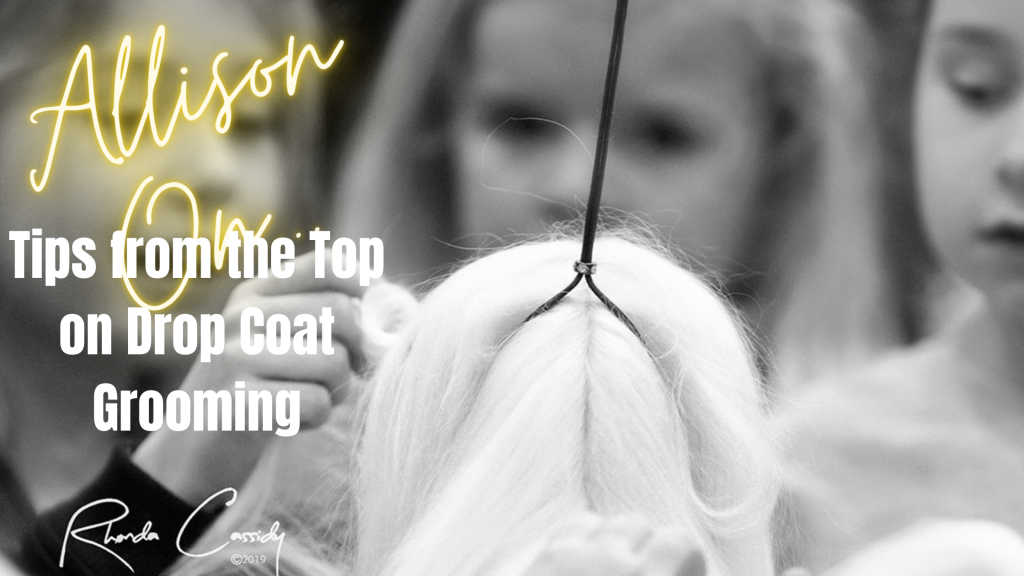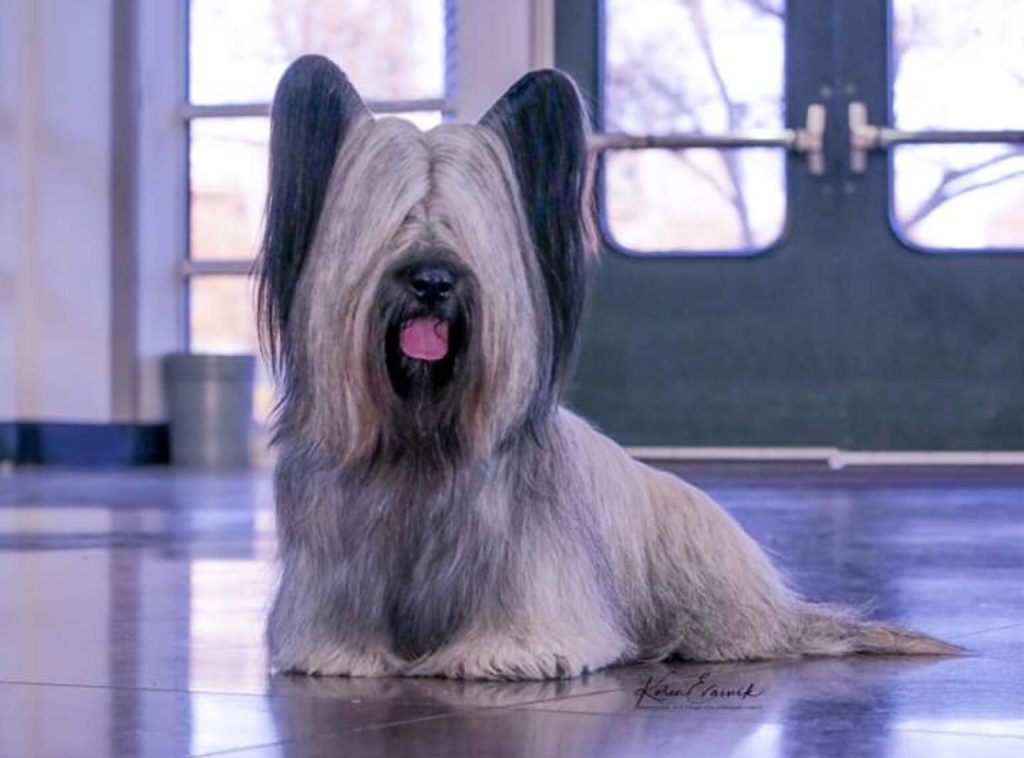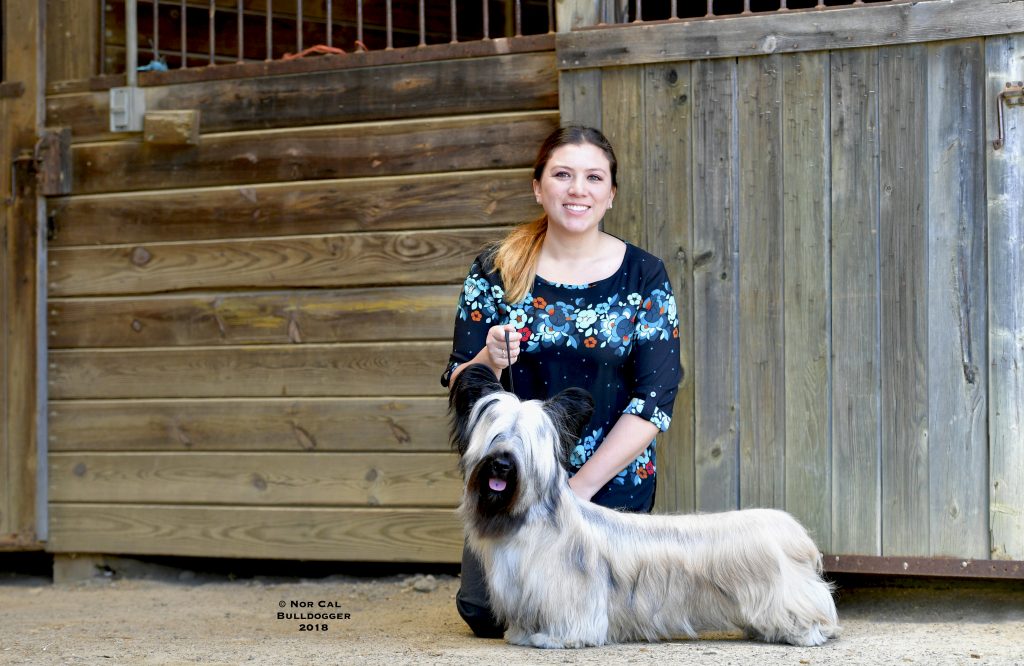465 – Allison On: Tips from the Top on Drop Coat Grooming
Allison On: Tips from the Top on Drop Coat Grooming
Allison Alexander, founder of Leading Edge Dog Show Academy and President of the Canadian Professional Handlers Association, joins host Laura Reeves to talk about grooming drop coated breeds, from maintenance to polish.
Allison’s years of experience provide enormous insight into the maintenance on coated breeds from a Maltese to a Briard. Along with professional tips on the tools of the trade…. What kind of pin brush, what type of wraps, HOW to wrap and band. We cover it all right here. Read on for just the tip of the iceberg. And click to listen to the entire fabulous conversation.
“Obviously the basics start with line brushing,” Allison said. “And one thing I will say about drop coats, and people might disagree with me, but drop coats more than any other coat type, you can’t have a bad day.
“Even a poodle in full show coat, you can skip a bath. They could get wet in a rainstorm or snowstorm and it’s midnight and you’ve driven for two days to get home and, I’m not recommending it, but you can let them get away with like towel him dry, sleeping it off overnight and starting the next day. You have a long coat, especially as single-coated long coat, and you do not have those options.
“So the commitment is like times 10 to me. There are no days off. So when it comes to line brushing to me to keep a really fully coated drop coat breed in coat, line brushing has to be something that you’re doing every day. You’re going to change those wraps every day. You’re going to change that topknot every day. You’re going to make sure that they look perfect.
“When it comes to line brushing, my kind of general rule of thumb is, the longer the coat the more coat they have, the longer the pin in the pin brush. When it comes to a single-coated drop coat, I’m going to use a brush with a slightly softer pad firmness. The double-coated drop coats, I’m going to use a brush that has a slightly firmer pad that the pins go in.
“We also know that no matter what we’re brushing, but again more important for long coats, never, ever brush the coat dry. You need some kind of brushing spray, whether it’s a brushing spray that’s just cutting down on static, whether it’s one that’s adding some kind of conditioner to the coat or whether it’s a detangling brushing spray. But they cannot be brushed dry. You’ll just keep snapping those ends off.
“When I am line brushing, I like to teach my dog to lay down on their side. Especially a drop coat because obviously, with that longer outer coat hanging down, you’re not going to get underneath. So if you’re drop coated dog is standing up, even if it’s a Skye terrier, even if it’s a Briard, how are you going to hold all of that coat up out of your way. You’re not going to be able to do that. So the first thing you can do is teach your dog to lay down on the table.
“Remember that our grooming tables are fabulous, they have non slip surfaces, but they are not the thing that our dog really wants to lay on. When I’m laying my dogs down to be line brushed, they typically have maybe a yoga mat, a grooming mat or like a thin dog bed, at the very least a nice thick bath towel underneath them. Mine typically have some kind of grooming mat and then a nice thick bath towel underneath them so that they’re comfortable. ‘Cause you’re going to be here for awhile.
“You’re going to start at the very shortest hair like as far down on the belly as you can and then I like to take the sections when I’m line brushing… so line brushing actually means going line by line through the coat… you have to create those lines. So, you’re creating those lines, typically you could use a knitting needle. I like to use a plastic rat tail comb. Some people use a metal rat tail comb, some people get really good at using their fingers.
“I like to go about a finger width between each line ’cause sometimes people are lined brushing but they’re using like 3 inches of code at a time and wondering why they’re not getting the same results so a fingers width. Obviously like on a little dog like a Maltese it probably would be my little finger and probably on a bigger dog like a Skye terrier, a Briard, it would be like a bigger finger.
“You’re going to take a layer coat, you’re going to mist it with whatever your brushing spray is, brush it with your pin brush, check it with your comb. We’re not using our comb to groom the dog because otherwise you’re going to be removing too much coat. We’re using the comb to check that we did get all the way down to the skin from one end of that line that we did (to the other.)
“Typically I’m going to go from the belly to the top line. Then I’m going to do each leg in the same manner. I don’t typically do the legs or the tail or the neck at the same time. I go from the armpit to the loin area all the way up from the belly. Then I’m going to the front leg from the bottom of the foot up. Back leg, under the tail, the tail, then the neck. It’s in sections. An it’s line by line by line.”
382 – Skye Terriers: Hardy, Devoted Breed of the Scottish Isles
Skye Terriers: Hardy, Devoted Breed of the Scottish Isles
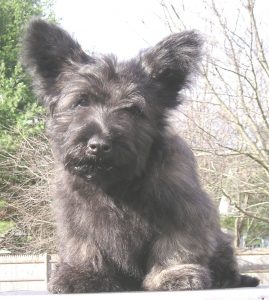
Skye Terrier puppy
Our panel of Skye Terrier breeders represents nearly 150 years combined experience in the breed. Michael Pesare, Elaine Hersey and Karen Turnbull join host Laura Reeves to share their love of this hardy, devoted breed of the Scottish Isles.
Depicted in art through centuries and with history dating back to the 1500s, the Skye is an old breed.
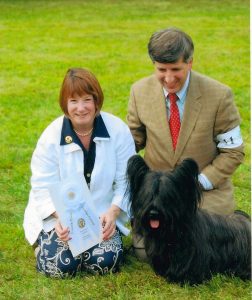
Michael Pesare
“The Skye definitely shares his heritage with a number of other terrier breeds from the Western Isles,” Pesare said, “the West coast of Scotland, where it can be quite rugged, damp, cold, rocky … breeds like the Cairn, the Scottie, the Westie… they were kept by the land owners to rid the farms of vermin. But not just small vermin, we’re talking Otter, Badger, foxes all the vermin that would do damage to the crops… there are references to long legged terriers and short crooked legged terriers going back to the 1500s, and so our Skyes definitely have a very long history.”
An achondroplastic breed, the long, low Skye is heavy bodied and heavy boned.
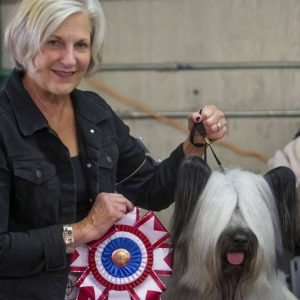
Karen Turnbull
“This is actually a very, very healthy breed,” Turnbull said. “I think because they’ve been rare that’s worked in their favor and there are very hardy breed, a sturdy breed … one question that we get frequently because they are a long and low breed I think people instantly think back problems. Our breed is not prone to back problems. The first thing I do when people say that is I invite him to feel the back and feel the legs. They’re always surprised because they have so much bone and there’s such a sturdy dog … people are always surprised at how much dog is underneath that coat.”
Made famous for their loyalty by the story of Grayfriars Bobby, the Skye is deeply devoted to its family.
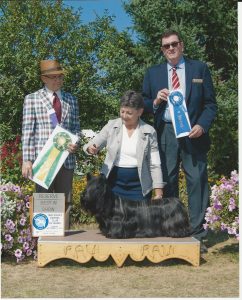
Elaine Hersey
“It’s a breed that wants to be with its person,” Hersey said. “They are very, very sensitive. They are very intuitive. They love their people. They’re not a breed that you can put out in the backyard and forget about. They need to have, I think, early socialization. They need to have continued socialization as a puppy if you want to have the best Sky you can. So they need somebody that’s committed to doing the work and then they’re going to have a wonderful, wonderful dog.”
For more information about the Skye Terrier, visit the Skye Terrier Club of America.
344 – Inspiring True Story: From First Show to Best in Show
Inspiring True Story: From First Show to Best in Show
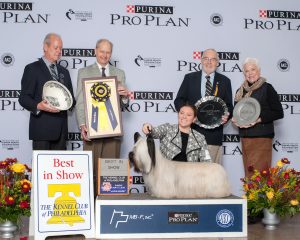
Antoinelle Vulpis and “Archer” winning BIS Sunday at The Kennel Club of Philadelphia.
Antoinelle Vulpis chose a Skye Terrier as her first show dog. Two years after their first show, Vulpis and Archer won Best in Show at The Kennel Club of Philadelphia’s National Dog Show.
Vulpis offers another inspiring “newbie” story as she shares her journey, the importance of her breeders/mentors and the support of the dog show community.
“I grew up like any kid watching Westminster on TV. We had Golden Retrievers as family dogs, but I always kind of wanted something a little different. I was a total dog geek,” Vulpis said.
After college, Vulpis got a job at AKC that required her to attend dog shows.
“I decided I wanted to try this myself. Then I saw Larry Cornelius and Charlie the Skye Terrier. THAT was the dog for me,” Vulpis said.
Parent Clubs and Handlers
Vulpis made contact with Michael Pesare through the Skye Terrier Club of America. She then waited a year for the right dog from the right litter.
Her puppy arrived exactly two years before her first best in show.
“My mentors drove three hours one way without a dog entered just to cheer me on at my first dog show,” Vulpis said. Her breeders helped her learn how to groom the rare breed and supported her at every step, she added.
“My handler friends are so willing to help me and share. They’re the people who inspire me. I try to learn from them,” Vulpis said. “Asking someone more experienced than you will really pay off.”
Vulpis counts professional handlers from Greg Strong to Ernesto Lara in her list of people who have helped her along the way.
Listen to the input
“I asked all kinds of people for advice,” Vulpis said.
Vulpis’ favorite grooming product is #1 All Systems Invisible Hold “It’s the holy grail for keeping the part to stay in place.”
“I don’t brush him every day because it takes hair out. Only once or twice a week to keep mats under control. I keep him clean, and bathe him weekly,” Vulpis noted.
“Now that I’m realizing I can make a difference in how he’s presented and how he looks. I get to the dog show early and spend time bathing his under-carriage and blow dry him. The extra time and care really has paid off,” Vulpis said.
For more stories from new people to the sport, listen here and here.

